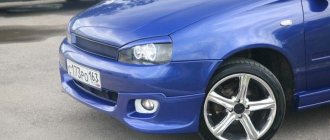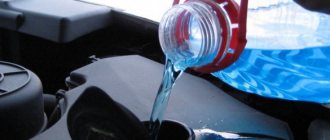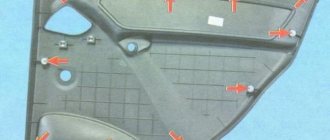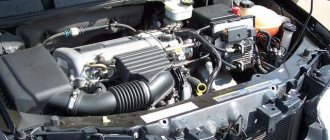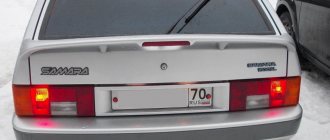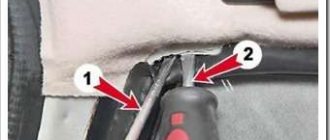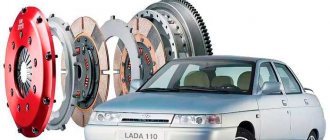One bad thing happened to me, after buying the car I went to register it, and the tint on the rear lights did its job, they didn’t register the car, I couldn’t think of anything from a bribe to new headlights, but the funds didn’t allow me, I decided to get rid of the toner myself . Several methods were tried, including brake fluid, various solvents, but they did not give the desired result. The paint held on like a partisan during interrogation. It was decided to polish. After a trip to the auto and hardware stores, the following were purchased: 1. Set for polishing headlights - LAVR
It includes 3 types of sandpaper numbered 1-2-3 Number 1, respectively, the coarsest grit - 800, Number 2, medium grit 1500, Number 3, the smallest grit 2000. The set included a polishing compound consisting of wax and abrasive for finishing . We also purchased 400-grit grinding wheels for directly removing varnish from headlights (the roughest treatment) and a grinding wheel.
How to remove tint from headlights
Nikittaa 09.14.2008 - 10:03
(The car is really Russian, well, the varnish seems to come from a spray can that they sell in the markets)
Post edited by Nikittaa: 09.14.2008 - 13:06
Greetings! Optical tuning has been very popular lately. You can do anything with the headlights: xenon, bi-xenon, LEDs, eyelashes, tinting. The only question is how legal and practical is all this?
Not everyone likes all these modifications, and sometimes the “beauty” that was created by the previous owner has to be corrected by the new owner of the “tuned” car. It is also not uncommon to have to refuse and return the optics to their original condition due to refusal to undergo technical inspection. Yes, yes, it happens. When, because of your “cool” optics, you cannot pass a technical inspection or constantly receive fines and comments from the traffic police, then whether you like it or not, you need to somehow solve the problem.
If there is xenon and you get a lot of trouble because of it, remove it and bring the headlights into compliance with the requirements. If these are LEDs, put the halogens back. If it is a tint film, remove it. What if it's varnish? In this case, you will have to sweat.
In this article I’ll tell you about working (and not so working) methods for removing tinted varnish. You will learn how to effectively remove tint from headlights without damaging them.
So, I’ll start with the least effective, in my opinion, gradually moving on to more workable methods
- Glass replacement. Complete replacement of the headlight glass is a radical method; only a complete replacement of the headlight assembly will be more radical. The process is labor-intensive and requires certain skills and tools, as well as spare glasses. The headlights warm up, after which the sealant softens and allows the glass to separate from the body.
- Mechanical removal. I also consider this method of removing varnish from headlight glass to be radical and recommend using it only if other means have failed. This option involves removing headlight tint using an abrasive. That is, roughly speaking, sandpaper will be used, with which the varnish layer will be erased. The disadvantage of this method is that it is labor-intensive and also radical; the top layer of glass will be removed along with the varnish layer, which will lead to clouding and weakening of its protective properties.
- Nail polish remover (for nails). The principle is this: apply a little product to a rag, wet the painted area, and then quickly remove everything using a rag soaked in solvent. If you delay or do not calculate it, you can get the opposite effect - the plastic will become cloudy or white. In general, there is a high probability of destroying the glass.
- Professional liquid for removing tinted varnish. This product is specially designed for such work, so there should be no harm from it, and the effect is usually positive. Of course, this is not cheap, but it is many times cheaper and more convenient than buying new glass or sanding it with sandpaper. In addition, the simplicity of the method should be taken into account. Unlike all those described above, it is tritely simple: we apply the product to the tint and give the liquid time to react. After the varnish begins to swell, remove it with a rag.
How to remove tint varnish from headlights? How to “untone” varnished headlights?
Greetings! Optical tuning has been very popular lately. You can do anything with the headlights: xenon, bi-xenon, LEDs, eyelashes, tinting. The only question is how legal and practical is all this?
Not everyone likes all these modifications, and sometimes the “beauty” that was created by the previous owner has to be corrected by the new owner of the “tuned” car. It is also not uncommon to have to refuse and return the optics to their original condition due to refusal to undergo technical inspection. Yes, yes, it happens. When, because of your “cool” optics, you cannot pass a technical inspection or constantly receive fines and comments from the traffic police, then whether you like it or not, you need to somehow solve the problem.
If there is xenon and you get a lot of trouble because of it, remove it and bring the headlights into compliance with the requirements. If these are LEDs, put the halogens back. If it is a tint film, remove it. What if it's varnish? In this case, you will have to sweat...
In this article I’ll tell you about working (and not so working) methods for removing tinted varnish. You will learn how to effectively remove tint from headlights without damaging them.
So, I’ll start with the least effective, in my opinion, gradually moving on to more workable methods
- Glass replacement. Complete replacement of the headlight glass is a radical method; only a complete replacement of the headlight assembly will be more radical. The process is labor-intensive and requires certain skills and tools, as well as spare glasses. The headlights warm up, after which the sealant softens and allows the glass to separate from the body.
- Mechanical removal. I also consider this method of removing varnish from headlight glass to be radical and recommend using it only if other means have failed. This option involves removing headlight tint using an abrasive. That is, roughly speaking, sandpaper will be used, with which the varnish layer will be erased. The disadvantage of this method is that it is labor-intensive and also radical; the top layer of glass will be removed along with the varnish layer, which will lead to clouding and weakening of its protective properties.
- Nail polish remover (for nails). The principle is this: apply a little product to a rag, wet the painted area, and then quickly remove everything using a rag soaked in solvent. If you delay or do not calculate it, you can get the opposite effect - the plastic will become cloudy or white. In general, there is a high probability of destroying the glass.
- Professional liquid for removing tinted varnish. This product is specially designed for such work, so there should be no harm from it, and the effect is usually positive. Of course, this is not cheap, but it is many times cheaper and more convenient than buying new glass or sanding it with sandpaper. In addition, the simplicity of the method should be taken into account. Unlike all those described above, it is tritely simple: we apply the product to the tint and give the liquid time to react. After the varnish begins to swell, remove it with a rag.
Here's what the headlight tuning process looks like:
We remove the headlight. We clean from dirt and dust.
Apply nail polish remover and wait until it starts to lift. The varnish will begin to swell and “bubble”, after which we remove it with a rag. We carry out several such cycles until the varnish is completely gone.
After completing the process of removing headlight tint, it is advisable to “polish” them to restore their natural shine.
Photo from here: https://www.drive2.ru/l/8257205/
Film removal steps
There are many methods for removing film from car headlights. Often this can be done quickly. This procedure consists of several stages that usually last no more than an hour.
Removing the blackout
Before starting work, you must prepare the necessary tools and materials. Removing tinting is not complete without a utility knife or other sharp object, soapy water or window cleaner, and rags. Their presence is mandatory when using any method. It is advisable to have alcohol (ethyl or ammonia) or gasoline on hand to wash off traces of the adhesive composition. A sander and polish may be needed to restore the shine of the headlights.
Removing the blackout
Removing film stickers from light fixtures is usually easy to do yourself. To do this, as a rule, you do not need to contact a car service. This may only be necessary in the case of coatings that are difficult to peel off or if there are surface defects. It is advisable to entrust the elimination of such problems to specialists.
Using tint removal methods
Before starting work, the surface of the lamps or headlights should be washed with warm water and car shampoo or detergent. After inspection, a decision is made to apply a specific cleaning method.
If the film does not hold tightly or peels off, it can be removed mechanically. To do this, you need to pry off the edges of the sticker with a knife or scraper, and then remove the tint with your hands. Sometimes they do without sharp objects. The sticker can be easily peeled off with your fingers. The technique only works on expensive coatings with high-quality glue. It is not effective when using cheap tint products or when they were installed a long time ago.
After using this method, it may be necessary to remove the remaining adhesive with alcohol, gasoline or another solvent. It is not advisable to use aggressive chemicals for this. It can cause permanent clouding of the surface. It is often impossible to get rid of it even by polishing. These headlights will have to be replaced. Sometimes you can remove the glue with window cleaner or soap solution.
Using a hair dryer to tint headlights
A freshly washed coating can be wetted with ammonia, ammonia or ethyl alcohol. Cover the top with a plastic bag and leave in the sun for a while. Then you just have to remove the sticker with your fingers. This method is very effective. It rarely leaves glue stains behind.
Sometimes other solvents are used. But their use can lead to clouding of the glass or the formation of other defects. It is especially not recommended to use acetone and its derivatives.
Final cleaning and tinting of headlights
After removing the sticker, traces of the adhesive composition often remain on the lanterns. You can remove them with a cloth moistened with a solution of soap or detergent. Ammonia or ammonia removes such contamination well. Gasoline can be used. Upon completion of work, it is recommended to thoroughly wash the surface with water and wipe.
Sometimes scratches, abrasions and other defects are visible on detonated headlights. They can be removed by polishing. It is performed with a grinding machine using glass polish. Before doing this, you need to protect the paintwork with masking tape. You can polish the headlights yourself. But if you lack experience, it is recommended to contact a car service, as there is a risk of overheating and damage to parts.


